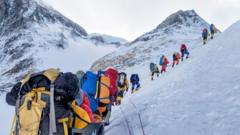Nepal is set to raise the cost of climbing Mount Everest for the first time in almost ten years, as officials announce a significant hike in permit fees. Beginning this September, climbers aiming to reach the summit of the tallest mountain on Earth will need to pay $15,000 (£12,180), representing a 36% increase from the previous fee of $11,000. Those looking to climb outside the peak season from April to May will also see a corresponding price rise — with fees set at $7,500 during September to November and $3,750 over the winter months from December to February.
Permit fees are a crucial source of income for Nepal, as climbing and trekking contribute over 4% to the national economy. However, Nepal's government has faced criticism from mountaineering experts for the excessive number of permits allotted annually, with around 300 issued each year for Everest. It remains uncertain whether the fee increase, which has been in discussion since last year, will curtail interest in climbing the iconic peak.
According to Narayan Prasad Regmi, the director general of the Department of Tourism, the royalty fees had not been updated for an extended period, prompting the recent adjustment. Yet, Regmi did not elaborate on how the generated funds would be allocated. British mountaineer Kenton Cool, who has summited Everest 18 times, commented that the fee increase is unlikely to deter most climbers, and expressed hope that the additional revenue would be utilized effectively.
In a related context, the Nepalese Supreme Court issued an order in April 2024 directing the government to manage the number of climbing permits for Everest and other peaks, emphasizing the need to respect the mountains' capacities. Although the interim ruling did not stipulate a specific limit, it highlights growing concerns about the overcrowding risks climbers face, including the infamous queues at dangerous heights.
The Nepalese army has also undertaken measures to address environmental issues on Everest. Since 2019, annual clean-up operations have removed 119 tonnes of waste, 14 human remains, and several skeletons, indicating the mountain's ongoing struggle against litter and mortality. Despite these efforts, it is estimated that around 200 bodies remain lost on the mountain, raising broader questions about climbing ethics and responsibilities.
With eight of the world's 14 highest peaks located in Nepal, the country continues to attract mountaineers from across the globe, but the balance between tourism and conservation remains an ongoing challenge for officials.





















